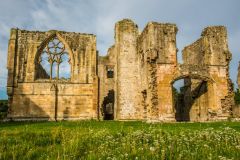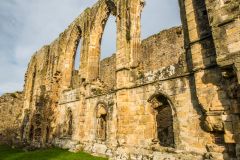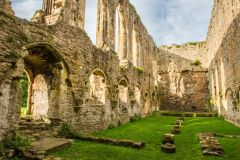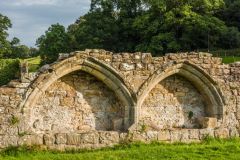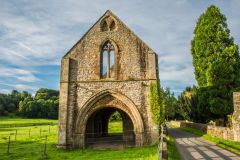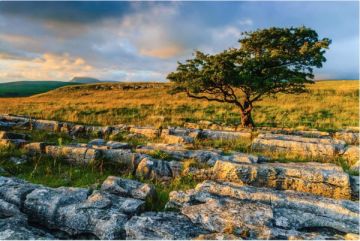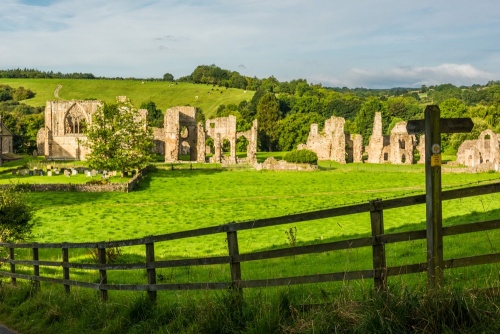
In 1152 Roald, the Constable of Richmond Castle, granted land to a group of Premonstratensian canons to build an abbey on the banks of the River Swale, within sight of the soaring towers of his castle.
Roald did not own the castle, but administered it on behalf of his patron, Conan, Earl of Richmond. But Roald was certainly a wealthy man, probably through marriage to Garsia, widow of Enisan Murdac, who held large estates around Richmond after the Norman Conquest.
The new abbey may not have been the first religious foundation at Easby; circumstantial evidence suggests that there was a community of priests here in the Saxon period, perhaps associated with a minster church. It is unusual that Roald chose to establish a Premonstratensian house, though.
The Premonstratensians
The Premonstratensians were one of the smallest religious orders in England, and Easby was only the third abbey in the country to be established for them (after Newhouse in Lincolnshire and Alnwick in Northumberland). The canons were not monks, but ordained priests. They did not take monastic vows and could perform religious ceremonies, which monks could not.
So why did Roald choose to found an abbey for the order rather than, say, the Cistercians, who were by far the most popular order of the time? One possibility is that he couldn't, for in 1152 the General Chapter of the Cistercians ruled to put a freeze on establishing new monasteries, thinking that the order was expanding too quickly. Roald may simply have had to fall back to his 'second choice' religious order.
The new abbey was dedicated to St Agatha, and composed of a core of buildings for the monks to eat, sleep, and pray, and a large number of outbuildings within a perimeter wall.
The core abbey buildings included a church, sacristies (for keeping vestments, holy vessels, and written records), cloister, dorter (sleeping quarters), redorter (toilet block), refectory (dining hall), infirmary, chapter house, guest solar, and an abbot's lodging.
The ancillary buildings, further from the church, included a variety of barns and byres, a bakehouse, and a brewhouse. The precinct was entered through an impressive gatehouse, built in the early 14th century.
In addition to the buildings for the monks to live and work they constructed a hospital for 22 poor men. In those days a hospital was not simply a place to heal the sick but could serve as a sort of retirement home, or social housing, under the auspices of a religious house.
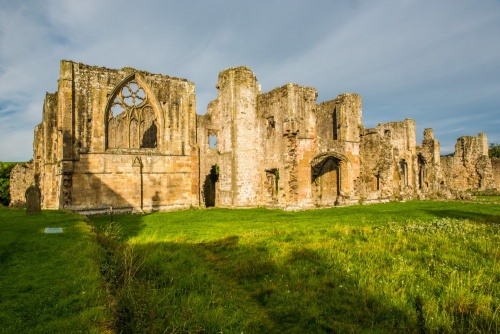
Patrons and Endowments
Roald initially endowed Easby with just 2 carucates of land, really not enough for a community of canons (a carucate is the amount of land a team of 8 oxen can till in a year - very roughly 120 acres). A local knight named Richard de Rolios granted another charter to Easby and seems to have considered the abbey his own foundation.
The Earl of Richmond added another 4 carucates of land and endowed Easby with the profits of the Richmond fair. The canons slowly created an income based on sheep farming, and eventually purchased the land that would become Easby manor.
The Scropes at Easby
In the 14th century, the powerful Scrope family of Bolton Castle in Wensleydale became patrons of Easby. The Scropes were buried at Easby, and surviving niches in the abbey church are thought to be remains of Scrope family tombs.
The Scrope tombs must have been quite impressive; the abbot of Easby was called as a witness in a court case in 1395 and in the court records he describes the tombs of Henry Scrope (d. 1336) and Sir William Scrope (d. 1344) in detail.
The abbot goes on to say that 'many other of their lineage are buried under flat sones, and upon the same stones are flatly graven their images for sculptures ...' In other words, there are a couple of very grand tombs and numerous other, less impressive, grave slabs of various Scropes throughout the church.
The Scrope family paid for the chancel of the church to be heightened, and in 1392 Sir Richard Scrope granted extensive lands to the abbey, greatly increasing the abbey's wealth and status.
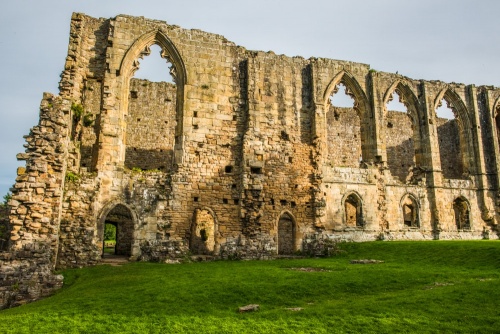
The Fugitive Canon
One interesting story attaches to Easby. In the late 15th century the head of the Premonstratensian order in England was Richard Redman, the abbot of Shap, in Cumbria. On one of his regular visitations to Easby in 1482, he was called upon to investigate the case of a canon named John Nym, who had run away when accused of having 'improper relations' with a widow named Elizabeth Wales.
Redman ruled that when John was found, he should be brought before a tribunal. John was indeed found, but was proved to be innocent. He was accepted back into the community of canons, and in 1492 he was named abbot.
Easby's time of prosperity in the period of Scrope patronage must have come to an end, for Redman found the abbey in debt, though well-maintained. However, the abbey never did recover its wealth, and by the time the abbey was dissolved by Henry VIII the number of canons living at Easby had diminished just 11. The end came in 1536, making Easby among the first monasteries to be dissolved. The land was then let to Lord Scrope of Bolton.
The Pilgrimage of Grace
In October of 1536 Easby was caught up in the turmoil of the Pilgrimage of Grace. This popular uprising, centred in the north, attempted to reverse the tide of Reformation and appeal to Henry VIII to reinstate Catholicism (and by extension, monasteries).
One of the centres of the Pilgrimage was Richmond, and in December 1536 the town's bailiffs had reinstated the canons at Easby. But Henry was not to be dissuaded from his course, and his vengeance upon the rebels was ferocious. He instructed his military leader in the north, the Duke of Norfolk, to 'cause the monks to be tied up without further delay'.
Tied up, in this case, certainly means to hang them. We have no record of whether Henry's sentence was carried out at Easby, or whether the canons were allowed to disperse.
Within only two years many of the abbey buildings had been destroyed and stripped for building materials, especially their lead roofing. However, enough of the abbey remained intact for it to become a popular destination for artists, including JMW Turner, drawn by the romantic ruins and the picturesque surroundings.
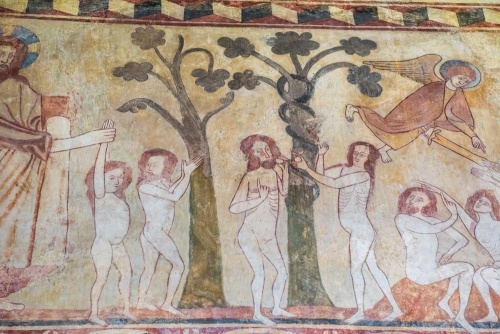
St Agatha's Church
One unusual feature at Easby is that the local parish church, also dedicated to St Agatha, stands within the abbey precincts. It is well worth exploring the church, which dates to the 12th century and has a quite wonderful collection of 13th-century wall paintings, created at the height of the abbey's wealth. One series of paintings depicts the Labours of the Months (that is, traditional seasonal activities).
Far older is a fragment of an early 9th-century cross found here, called The Easby Cross. Unfortunately, what we see is a cast of the original, which is now held at the Victoria and Albert Museum in London. The presence of the cross suggests a flourish Christian community at Easby long before the Premonstratensian monks arrived.
Not far away from the church is Easby Mill, a late 18th-century corn mill built on to of the original medieval watermill that served the abbey. Also nearby is Abbey House, a private dwelling created from the ruins of a medieval monastic barn.
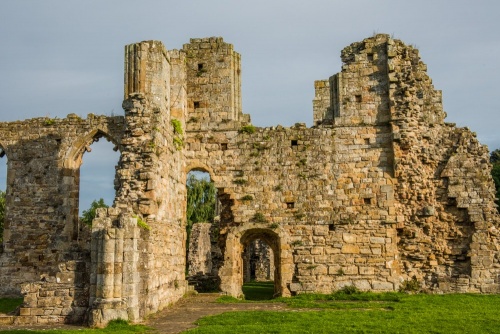
The oldest part of the abbey ruins is the church, which dates to the late 12th century. The buildings along the south and east range of the cloisters are 13th century, and the abbot's house was added around 1300. The most impressive ruin, however, is the early 14th-century refectory, still standing to roof height.
One of the finest remains of Easby Abbey is not at Easby at all; when the abbey was dissolved the Scropes of Bolton removed the 16th-century carved wooden screen from the abbey church and installed it in the parish church of Wensley, where it still stands. This beautifully carved screen gives us a sense of just how impressive the abbey must have looked.
Without doubt Easby is one of the most beautifully situated medieval monasteries in England.
About Easby Abbey
Address: B6272,
Richmond,
Yorkshire,
England, DL10 7EU
Attraction Type: Abbey
Location: At Easby, off Maison Dieu Road (B6272) immediately east of Richmond. Easby is open any reasonable time. Well signposted. Free parking on site.
Website: Easby Abbey
English Heritage - see also: English Heritage memberships (official website)
Location
map
OS: NZ186000
Photo Credit: David Ross and Britain Express
POPULAR POSTS
HERITAGE
 We've 'tagged' this attraction information to help you find related historic attractions and learn more about major time periods mentioned.
We've 'tagged' this attraction information to help you find related historic attractions and learn more about major time periods mentioned.
Historic Time Periods:
Find other attractions tagged with:
12th century (Time Period) - 13th century (Time Period) - 14th century (Time Period) - 15th century (Time Period) - 16th century (Time Period) - 18th century (Time Period) - 9th century (Time Period) - castle (Architecture) - chapter house (Architecture) - Henry VIII (Person) - JMW Turner (Person) - Medieval (Time Period) - Norman (Architecture) - Reformation (Historical Reference) - Saxon (Time Period) - wall painting (Historical Reference) - wall paintings (Historical Reference) -
NEARBY HISTORIC ATTRACTIONS
Heritage Rated from 1- 5 (low to exceptional) on historic interest
Easby, St Agatha's Church - 0.2 miles (Historic Church) ![]()
Richmond, St Marys Church - 1 miles (Historic Church) ![]()
Millgate House and Gardens - 1 miles (Garden) ![]()
Richmond Castle - 1 miles (Castle) ![]()
Green Howards Museum - 1.1 miles (Museum) ![]()
Richmondshire Museum - 1.1 miles (Museum) ![]()
Bargate - 1.1 miles (Historic Building) ![]()
Georgian Theatre Royal & Museum - 1.2 miles (Historic Building) ![]()
